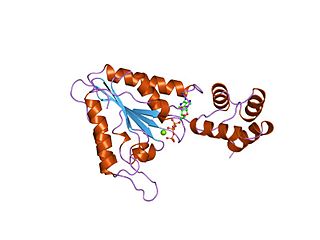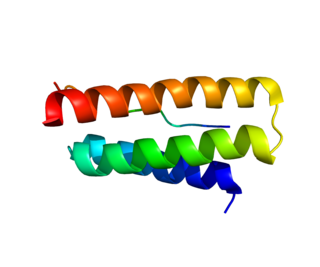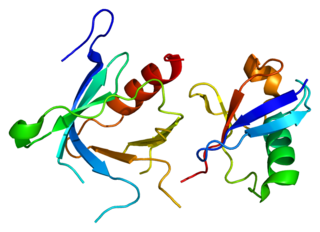Vacuolar protein sorting-associated protein 4A is a protein that in humans is encoded by the VPS4A gene. [5] [6] [7]
Vacuolar protein sorting-associated protein 4A is a protein that in humans is encoded by the VPS4A gene. [5] [6] [7]
The protein encoded by this gene is a member of the AAA protein family (ATPases associated with diverse cellular activities), and is the homolog of the yeast Vps4 protein. In humans, two paralogs of the yeast protein have been identified. They share a high degree of amino acid sequence similarity with each other, and also with yeast Vps4 and mouse proteins. Functional studies indicate that both human paralogs associate with the endosomal compartments, and are involved in intracellular protein trafficking, similar to Vps4 protein in yeast. The gene encoding this paralog has been mapped to chromosome 16; the gene for the other resides on chromosome 18. [7]

AAA proteins or ATPases Associated with diverse cellular Activities are a protein family sharing a common conserved module of approximately 230 amino acid residues. This is a large, functionally diverse protein family belonging to the AAA+ protein superfamily of ring-shaped P-loop NTPases, which exert their activity through the energy-dependent remodeling or translocation of macromolecules.

Tumor susceptibility gene 101, also known as TSG101, is a human gene that encodes for a cellular protein of the same name.

Charged multivesicular body protein 2b is a protein that in humans is encoded by the CHMP2B gene. It forms part of one of the endosomal sorting complexes required for transport (ESCRT) - specifically ESCRT-III - which are a series of complexes involved in cell membrane remodelling. CHMP2B forms long chains that spiral around the neck of a budding vesicle. Along with the other components of ESCRT-III, CHMP2B constricts the neck of the vesicle just before it is cleaved away from the membrane.

Charged multivesicular body protein 3 is a protein that in humans is encoded by the VPS24 gene.

Vacuolar protein sorting-associated protein 4B is a protein that in humans is encoded by the VPS4B gene.

Vacuolar protein sorting-associated protein 28 homolog is a protein that in humans is encoded by the VPS28 gene.

Charged multivesicular body protein 4b is a protein that in humans is encoded by the CHMP4B gene.

Charged multivesicular body protein 4a is a protein that in humans is encoded by the CHMP4A gene.

Charged multivesicular body protein 5 is a protein that in humans is encoded by the CHMP5 gene.

Charged multivesicular body protein 6 is a protein that in humans is encoded by the CHMP6 gene.

Charged multivesicular body protein 2a is a protein that in humans is encoded by the CHMP2A gene.
It is a reference gene.

Charged multivesicular body protein 1a is a protein that in humans is encoded by the CHMP1A gene.

Vacuolar protein-sorting-associated protein 36 is a protein that in humans is encoded by the VPS36 gene.

Vacuolar protein sorting-associated protein VTA1 homolog is a protein that in humans is encoded by the VTA1 gene.

Charged multivesicular body protein 1b is a protein that in humans is encoded by the CHMP1B gene.

Charged multivesicular body protein 4c is a protein that in humans is encoded by the CHMP4C gene.

Vacuolar protein sorting-associated protein 33A is a protein that in humans is encoded by the VPS33A gene.

Vacuolar protein-sorting-associated protein 25 is a protein that in humans is encoded by the VPS25 gene.
The endosomal sorting complexes required for transport (ESCRT) machinery is made up of cytosolic protein complexes, known as ESCRT-0, ESCRT-I, ESCRT-II, and ESCRT-III. Together with a number of accessory proteins, these ESCRT complexes enable a unique mode of membrane remodeling that results in membranes bending/budding away from the cytoplasm. These ESCRT components have been isolated and studied in a number of organisms including yeast and humans. A eukaryotic signature protein, the machinery is found in all eukaryotes and some archaea.

Vacuolar protein sorting 37 homolog A is a protein in humans that is encoded by the VPS37A gene. It is a member of the endosomal sorting complex required for transport (ESCRT) system.